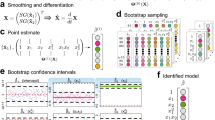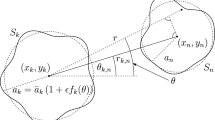Abstract
The determination of the exact trajectories of mutually interacting masses (the n-body problem1,2) is apparently intractable for n ⩾ 3, when the generic solutions become chaotic. A few special solutions are known, which require the masses to be in certain initial positions; these are known as ‘central configurations’ (refs 1,2,3,4,5,6) (an example is the equilateral triangle formed by the Sun, Jupiter and Trojan asteroids). The configurations are usually found by symmetry arguments. Here I report a generalization of the central-configuration approach which leads to large continuous families of approximate solutions. I consider the uniform motion of equidistributed masses on closed space curves, in the limit when the number of particles tends to infinity. In this situation, the gravitational force on each particle is proportional to the local curvature, and may be calculated using an integral closely related to the Biot–Savart integral. Approximate solutions are possible for certain (constant) values of the particle speed, determined by equating this integral to the mass times the centrifugal acceleration. Most smooth, closed space curves contain such approximate solutions, because only the local curvature is involved. Moreover, the theory also holds for sets of closed curves, allowing approximate solutions for knotted and linked configurations.
This is a preview of subscription content, access via your institution
Access options
Subscribe to this journal
Receive 51 print issues and online access
$199.00 per year
only $3.90 per issue
Buy this article
- Purchase on Springer Link
- Instant access to full article PDF
Prices may be subject to local taxes which are calculated during checkout




Similar content being viewed by others
References
Diacu, F. & Holmes, P. Celestial Encounters (Princeton Univ. Press, (1996)).
Meyer, K. & Hall, G. R. Introduction to Hamiltonian Dynamical Systems and the N-Body Problem (Springer, New York, (1992)).
Saari, D. On the role and properties of n-body central configurations. Celest. Mech. 21, 9–20 (1980).
Moeckel, R. On central configurations. Math. Z. 205, 499–517 (1990).
Buck, G. On clustering in central configurations. Proc. Am. Math. Soc. 108, 801–810 (1990).
Llibre, J. On the number of central configurations in the n-body problem. Celest. Mech. 50, 89–96 (1991).
Ricca, R. L. Rediscovery of Da Rios equations. Nature 352, 561–562 (1990).
Saffman, P. G. Vortex Dynamics (Cambridge Univ. Press, (1992)).
Buck, G. Four-thirds power law for knots and links. Nature 392, 238–239 (1998).
Buck, G. & Simon, J. Thickness and crossing number of knots.In Topol. Appl. (in the press).
Moffatt, H. K. The energy spectrum of knots and links. Nature 347, 367–369 (1990).
O'Hara, J. Energy of a knot. Topology 30, 241–247 (1991).
Simon, J. in Proc. 1994 IMA Summer Program on Molecular Biology (eds Mesirov, J. P., Schulten, K. & Sumners, D. W.) 39–58 (IMA Vol. 82, Springer, New York, (1996)).
Stasiak, A. et al. Electrophoretic mobility of DNA knots. Nature 384, 122 (1996).
Acknowledgements
This work was supported in part by the National Science Foundation.
Author information
Authors and Affiliations
Corresponding author
Rights and permissions
About this article
Cite this article
Buck, G. Most smooth closed space curves contain approximate solutions of the n-body problem. Nature 395, 51–53 (1998). https://doi.org/10.1038/25684
Received:
Accepted:
Issue Date:
DOI: https://doi.org/10.1038/25684
This article is cited by
-
Orbits of all sorts
Nature (1998)
Comments
By submitting a comment you agree to abide by our Terms and Community Guidelines. If you find something abusive or that does not comply with our terms or guidelines please flag it as inappropriate.



